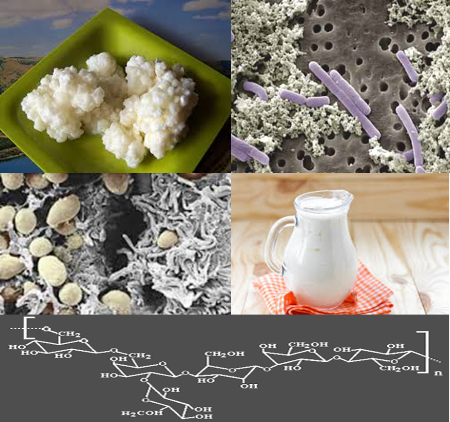
Chemical and microbiological composition of Kefir and its natural benefits
Abstract
Kefir grains or Tibetan mushrooms are considered a natural remedy thanks to their various curative properties against chronic diseases and certain cancers. They represent a symbiotic consortium of yeast and bacteria with high similarity to those present in the intestine. For this reason, the consumption reinforces the intestinal flora, helps with digestion, restores the digestive system and strongly stimulates the immune system.
In association with milk and slightly thickened with yogurt, kefir has the benefits of a pro-biotic since it is rich in vitamins, minerals and polysaccharides.
In this study we identified the diversity of bacteria, yeast and mould contained in kefir, a diversity which is important for its curative role in many disorders like diabetes and cancer. In a future study, we aim to investigate the mechanisms by which Kefiran; the main effective agent; regulates cell growth and immunity.
Full Text:
PDFReferences
Meyer, C., Denis, J.P Élevage de la vache laitière en zone tropicale, Cirad, Montpellier, 1999.
Beijerinck M.W. Sur le kéfir. Archives Néerlandaises des Sciences Exactes et Naturelles., 1889, 23, 428-444.
Ottogalli G., Galli A., Resmini P., Volonteriog G., Composizione microbiologica, chimica ed ultrastruttura dei granuli di kefir. Ann. Microbiol.,1973, 23, 109-121.
La Rivière J.W.M. & Kooiman P. Kefiran, a novel polysaccharide produced in the kefir grain by Lactobacillus brevis. Arch. Mikrobiol. 1967, 59, 269-278
Kooiman P., The water-soluble polysaccharide of the kefir grain. Carbohydrate research, 1968, 7, 200-211.
Zourari, A et Anifantakis, E.M. Le kéfir Caractères physico-chimiques, microbiologiques et nutritionnels. Le Lait, 1988, 68 (4), 373-392.
Ninane.V. Caractérisation du consortium microbien d’un grain de kéfir. Thèse de doctorat, Faculté Universitaire des Sciences Agronomiques, Gembloux. 2008.
PIDOUX. MLe grain de kéfir et sa formation thèse de 3eme cycle en science naturelle, 1985, p228, université Nantes, France
Jacquet J., Thevenot R. Le lait et le froid, J.B. Baillère, Paris, 1961, 216-218.
Koroleva N.SSpecial products (kefir, koumys, etc.). XXI Int, Dairy Congr, 1982, Vol. 2, 146-151
Kosikowskif V., Cheese and fermented milk food. Edwards Brothers, Michigan. 1977.
Glaeser H., Kefir: cultures, production, chemical composition and nutritive value. Erndhr Umsch., 1981. 28, 156-158.
Farber J.M., Sanders G.W., Dunfield S. & Prescott R. The effect of various acidulants on the growth of Listeria monocytogenes. Lett. Appl. Microbiol. 1989, 9, 181-193
Anonyme FDA Factors affecting the growth of some foodborne pathogens. In The "Bad Bug Book". Rockville, MD, USA : U.S. Food & Drug Administration. 1999.
Bhowmik T. & Marth E. Role of Micrococcus and Pediococcus species in cheese ripening: a review. J. Dairy Sci., 1990, 73, 859-866
Kocur M. (Genus I. Micrococcus Cohn. In Sneath P.H.A., ed. Bergey's manual of systematic bacteriology, Vol. 2. Baltimore, USA : William & Wilkins, 1986, 1004-1010
Klijn N., Weerkamp A.H. & De Vos W. Identification of mesophilic lactic acid bacteria by using polymerase chain reaction-amplifi, 1991.
Delfederico L., Hollmann A., Martinez M., Iglesias G., De Antoni G. & Semorile L. Molecular identification and typing of lactobacilli isolated from kefir grains. J. Dairy Res. 2006, 73, 20-27
Witthuhn R.C., Schoeman T. & Britz T. Isolation and characterization of the microbial population of different South African kefir grains. Int. J. Dairy Technol. 2004, 57, 33-37
Garrote G.L., Abraham A. G. & De Antoni G. L. Preservation of kefir grains, a comparative study. Lebensm. Wiss. Technol. 1997, 30, 77-84
Abraham A.G. & De Antoni G.LCharacterization of kefir grains grown in cows' milk and in soya milk. J. Dairy Res., 1999, 66, 327-333
Witthuhn R.C., Schoeman T. & Britz T. Characterisation of the microbial population at different stages of kefir production and kefir grain mass cultivation. Int. Dairy J., 2005, 15, 383-389
Fujisawa T., Adachi S., Toba T., Arihara K & Mitsuoka T. Lactobacillus kefiranofaciens sp. nov. isolated from kefir grains. Int. J. Syst. Bacteriol. 1988, 38, 12-14
Magalhaes KT, Pereira GVD,Campos CR, Dragone G, Schwan RF . Brazilian Kefir: Structure, Microbial Communities and Chemical Composition. Brazilian Journal of Microbiology. 2011, 42: 693-702.
Analy Machado de Oliveira Leite, Marco Antonio Lemos Miguel, Raquel Silva Peixoto, Alexandre Soares Rosado, Joab Trajano Silva, and Vania Margaret Flosi Paschoalin. Microbiological, technological and therapeutic properties of kefir: a natural probiotic beverage. Braz J Microbiol. 2013; 44(2): 341–349.
Maria R. Prado, Lina Marcela Blandón, Luciana P. S. Vandenberghe, Cristine Rodrigues, Guillermo R. Castro, Vanete Thomaz-Soccol, and Carlos R. Soccol. Milk kefir: composition, microbial cultures, biological activities, and related products. Front Microbiol. 2015; 6: 1177.
Seher Arslan. A review: chemical, microbiological and nutritional characteristics of kefir,
Journal of Food, 2015, Vol. 13, No. 3, 340–345
Refbacks
- There are currently no refbacks.
